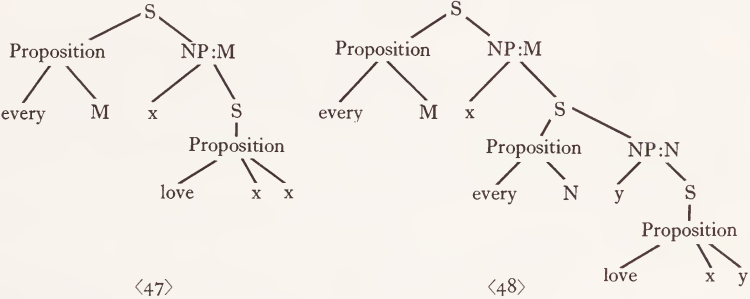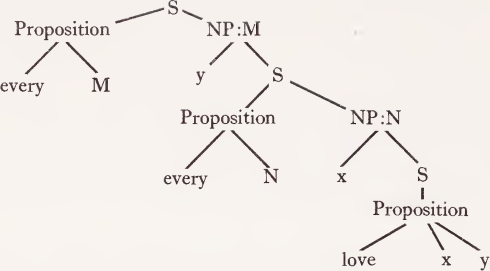


 Grammar
Grammar
 Tenses
Tenses
 Present
Present
 Past
Past
 Future
Future
 Parts Of Speech
Parts Of Speech
 Nouns
Nouns
 Verbs
Verbs
 Adverbs
Adverbs
 Adjectives
Adjectives
 Pronouns
Pronouns
 Pre Position
Pre Position
 Preposition by function
Preposition by function 
 Preposition by construction
Preposition by construction
 Conjunctions
Conjunctions
 Interjections
Interjections
 Grammar Rules
Grammar Rules
 Linguistics
Linguistics
 Semantics
Semantics
 Pragmatics
Pragmatics
 Reading Comprehension
Reading Comprehension|
Read More
Date: 2024-07-13
Date: 2023-08-08
Date: 2023-05-01
|
The above treatment of noun phrases necessitates some changes in the ‘base component’ of a grammar: a distinction between ‘Sentence’ and ‘Proposition’ must now be drawn; a Proposition is now a ‘ Contentive ’ plus a sequence of indices rather than a ‘ Contentive ’ plus a sequence of Noun Phrases, and an overall constraint on semantic representations must be imposed to insure that each representation contains neither too few nor too many noun phrases. An obvious first approximation to this constraint is to say that for each index in a semantic representation there must be at most one corresponding noun phrase, and that that noun phrase must be directly dominated by a S node which dominates all occurrences of that index. Some such constraint is needed anyway to exclude the possibility of saying
(38) Napoleon loves Bonaparte’s wife.
to mean that Napoleon loves his wife (cf. Gruber 1965). This constraint can be sharpened somewhat. If a personal pronoun occurs in a sentence which does not contain an antecedent for that pronoun, then either the pronoun has an antecedent in some preceding sentence of the discourse (possible a sentence spoken by someone other than the speaker of the sentence in question) or the pronoun is used deictically (i.e. is a direct reference to someone or something physically present as the sentence is uttered) and is stressed and accompanied by a gesture. Since the semantic function of the gesture which accompanies a deictic pronoun is the same as that of the lexical material of an ordinary noun phrase, it is tempting to suggest that in these sentences the gesture is a noun phrase, that the attachment transformation attaches that noun phrase to one of the occurrences of the index in question, and that the phonetic reflex of a gesture is stress. In support of this proposal, I note that a deictic pronoun may serve as the antecedent of a pronoun under exactly the same conditions under which an ordinary noun phrase may. For example, in
(39) After he left the office, he [gesture] went to the pool hall.
the first he may have the second as its antecedent. Such is not the case in
(40) He went to the pool hall after he [gesture] left the office.
This suggests tightening the constraint to make it say that for every index in a semantic representation there is exactly one corresponding noun phrase, except that a noun phrase may be omitted if there is a noun phrase with the same index in an earlier sentence of the discourse.
The proposal that pronouns are derived from index occurrences to which no noun phrase has been attached is further confirmed by the fact that pronouns do not admit ambiguities such as those of sentences (19) and (21)-(23): in the sentence
(41) My friends think that he is a woman.
the choice of he rather than she can only be on the basis of the speaker’s knowledge about the person being talked about and cannot be a report of the friends having said ‘ He is a woman ’ of a person who the speaker is convinced really is a woman.
The fact that noun phrases which have a non-restrictive clause are also unambiguously the speaker’s contribution:
(42) John said that his neighbor, who you met at Arthur’s party, has just been sent to Devil’s Island for possessing pot.
(note that this could not be followed by ‘. . . but the chap that John was talking about really isn’t his neighbor ’) indicates that the formation of non-restrictive clauses takes place before the attachment of noun phrases to their indices.
In German and Latin the ambiguity of sentences like (19) is resolved by the mood of the verb in the relative clause: in the de dicto meaning, lives is put in the subjunctive mood, and in the de re meaning it is put in the indicative mood. This indicates that mood is predictable on the basis of the structure prior to the NP-attachment transformation, specifically that a verb is made subjunctive if it is in a noun phrase which is within the complement of certain verbs at that point of the derivation.1
Regarding the distinction between ‘ Sentence ’ and ‘Proposition’, I observe that verbs differ as to whether they take a ‘ Sentence ’ or a ‘ Proposition ’ as complement, i.e. whether the complement may contain noun phrases as well as a proposition. The discussion implies that say, deny, and want take Sentences rather than Propositions as their complements. On the other hand, seem and begin take Propositions as complements: not that the sentences
(43) John began beating the man who lives at 219 Main St.
(44) Max seems to know the woman who lives at 219 Main St.
do not have the ambiguity which was noted in (19). However, if these sentences are embedded as the complements of verbs such as say or want, the result has the ambiguity:
(45) John wants to begin beating the man who lives at 219 Main St.
(46) Harry says that Max seems to know the woman who lives at 219 Main St.
The proposal that sentences are derived from structures in which the adjuncts to ‘ contentives ’ are indices rather than full noun phrases renders fairly trivial certain problems which would otherwise present considerable difficulty. For example, it is hard to see how the sentences
(47) Everyone loves himself.
(48) Everyone loves everyone.
could be assigned different ‘deep structures’ and how the reflexivization transformation could be formulated without ad-hoc restrictions if syntax were to start with ‘ deep structures’ in which full noun phrases like everyone rather than indices were to be the subjects, objects, etc. of verbs and reflexivization were to be contingent on noun phrases being identical. However, if sentences are derived from structures in which the adjuncts of ‘Contentives’ are indices, as in the semantic representations that I have proposed, (47) and (48) can be derived from the structures

Reflexivization is applicable only in the former tree.2 This proposal also explains why the sequence of words (48), when appropriately stressed, may mean either that everyone has the characteristic of loving everyone or that everyone has the characteristic that everyone loves him.3 The former meaning corresponds to the tree at the right above and the latter to

Both structures will yield the same sequence of words since in either case the two indices occurring next to love are the only places where the two occurrences of every may be attached to their indices by the transformation of quantifier-lowering (Carden 1968).
Finally, I observe that the data which I have discussed here show to be completely untenable the familiar proposal (Chomsky 1957) that each language has a limited repertoire of ‘ kernel sentences ’ and that the full range of sentences in the language is obtained by combining and deforming these kernel sentences in various ways. The sentences discussed require analyses in which structures containing less material than would make up a sentence (i.e. structures which have ‘slots’ for noun phrases but no corresponding lexical material) are embedded in structures which contain more lexical material than there are slots to put it into.
1 On the syntax of Latin subjunctives, see R. Lakoff (1969).
2 These trees are a minor modification of the structures proposed in Lakoff and Ross (1967).
3 These two meanings are ‘logically equivalent’: if either is true, then so is the other. It is of course reasonable to say that logically equivalent things need not have the same meaning, since any two contradictory propositions are logically equivalent, but one would hardly want to say that the sentences
(49) That horse is not a horse.
(50) My father had no children.
|
|
|
|
4 أسباب تجعلك تضيف الزنجبيل إلى طعامك.. تعرف عليها
|
|
|
|
|
|
|
أكبر محطة للطاقة الكهرومائية في بريطانيا تستعد للانطلاق
|
|
|
|
|
|
|
العتبة العباسية المقدسة تبحث مع العتبة الحسينية المقدسة التنسيق المشترك لإقامة حفل تخرج طلبة الجامعات
|
|
|